Management Accounting: Machinery Cost Analysis Report
VerifiedAdded on 2022/09/12
|6
|985
|16
Report
AI Summary
This management accounting report addresses a case study focused on Gibson Fabricators Corporation, which manufactures automotive parts and uses a job-order costing system. The core issue revolves around the potential cost savings from purchasing automated milling machinery. The report analyzes the impact of the machinery on the company's overhead rate, calculated based on direct labor hours, and assesses whether the investment would reduce overall costs or lead to increased overheads. The analysis includes calculations of total overheads, estimated production costs, and potential savings in labor costs, concluding that the machinery may not result in significant cost savings due to increased overhead rates and the offset of labor cost reductions. The report emphasizes the importance of considering the overall financial impact of such investments and the potential for reduced profits. It also mentions the unnecessary firing of workers and excess capacity caused by the investment. The conclusion suggests that the company might be better off without implementing the machinery.
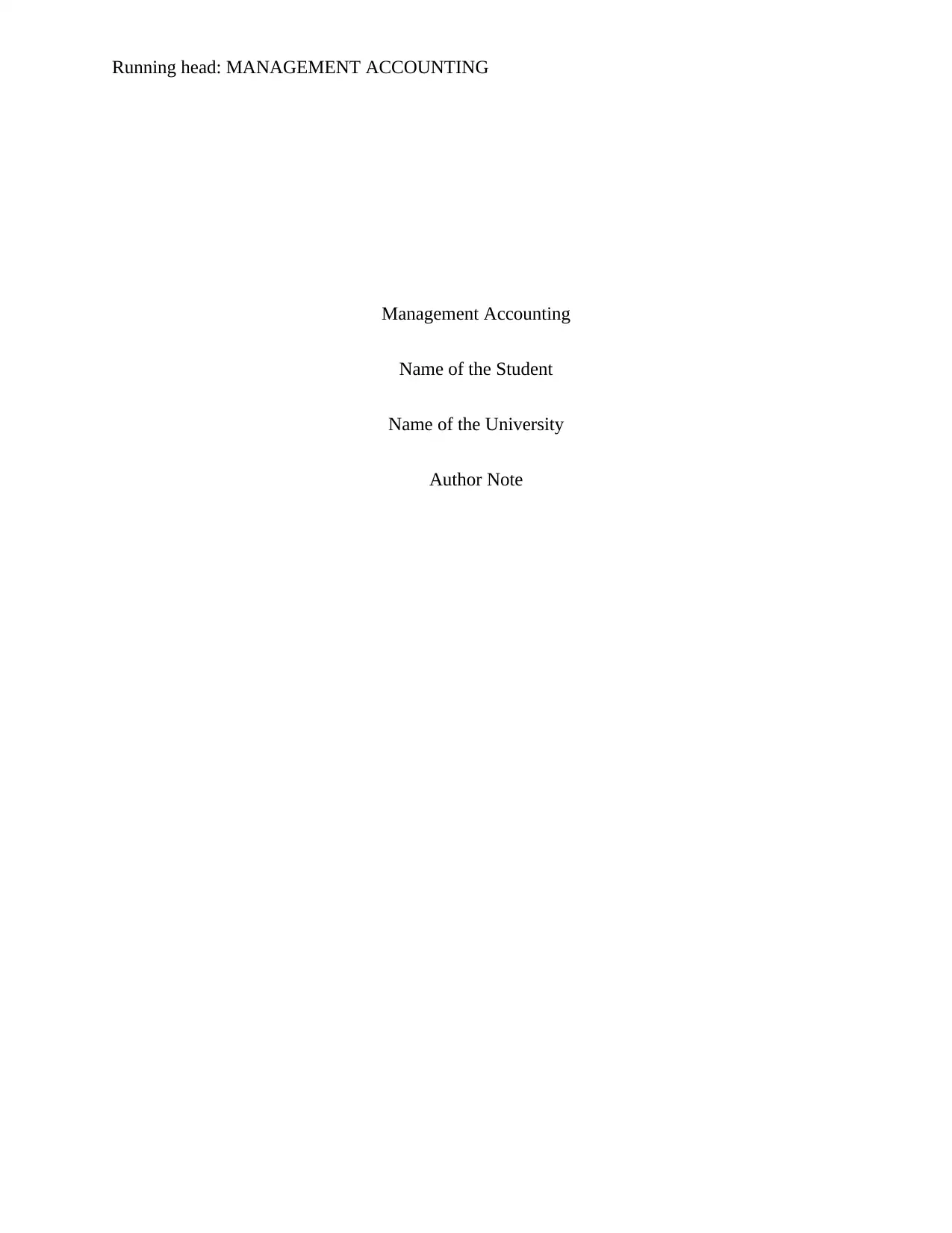
Running head: MANAGEMENT ACCOUNTING
Management Accounting
Name of the Student
Name of the University
Author Note
Management Accounting
Name of the Student
Name of the University
Author Note
Paraphrase This Document
Need a fresh take? Get an instant paraphrase of this document with our AI Paraphraser
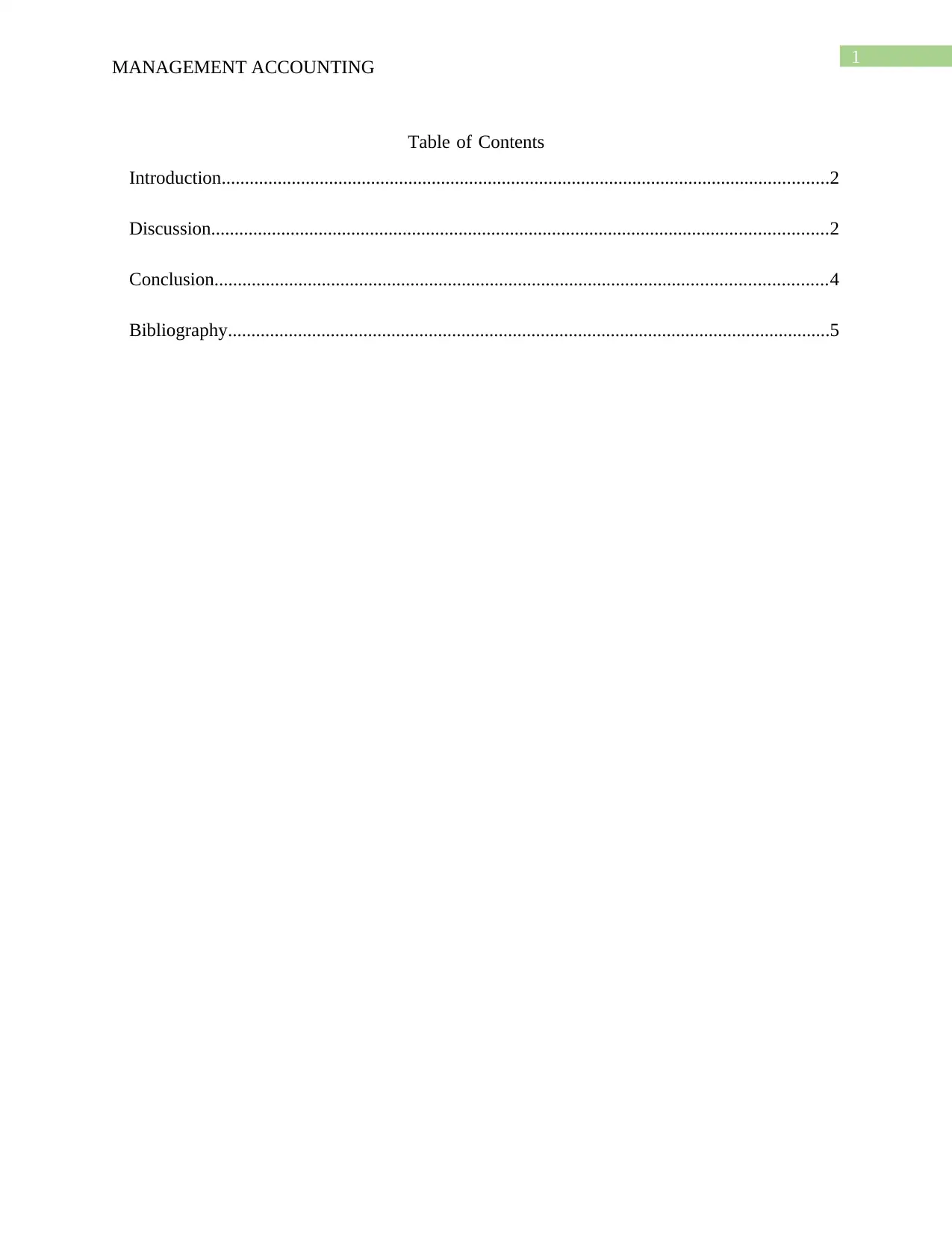
1
MANAGEMENT ACCOUNTING
Table of Contents
Introduction..................................................................................................................................2
Discussion....................................................................................................................................2
Conclusion...................................................................................................................................4
Bibliography.................................................................................................................................5
MANAGEMENT ACCOUNTING
Table of Contents
Introduction..................................................................................................................................2
Discussion....................................................................................................................................2
Conclusion...................................................................................................................................4
Bibliography.................................................................................................................................5
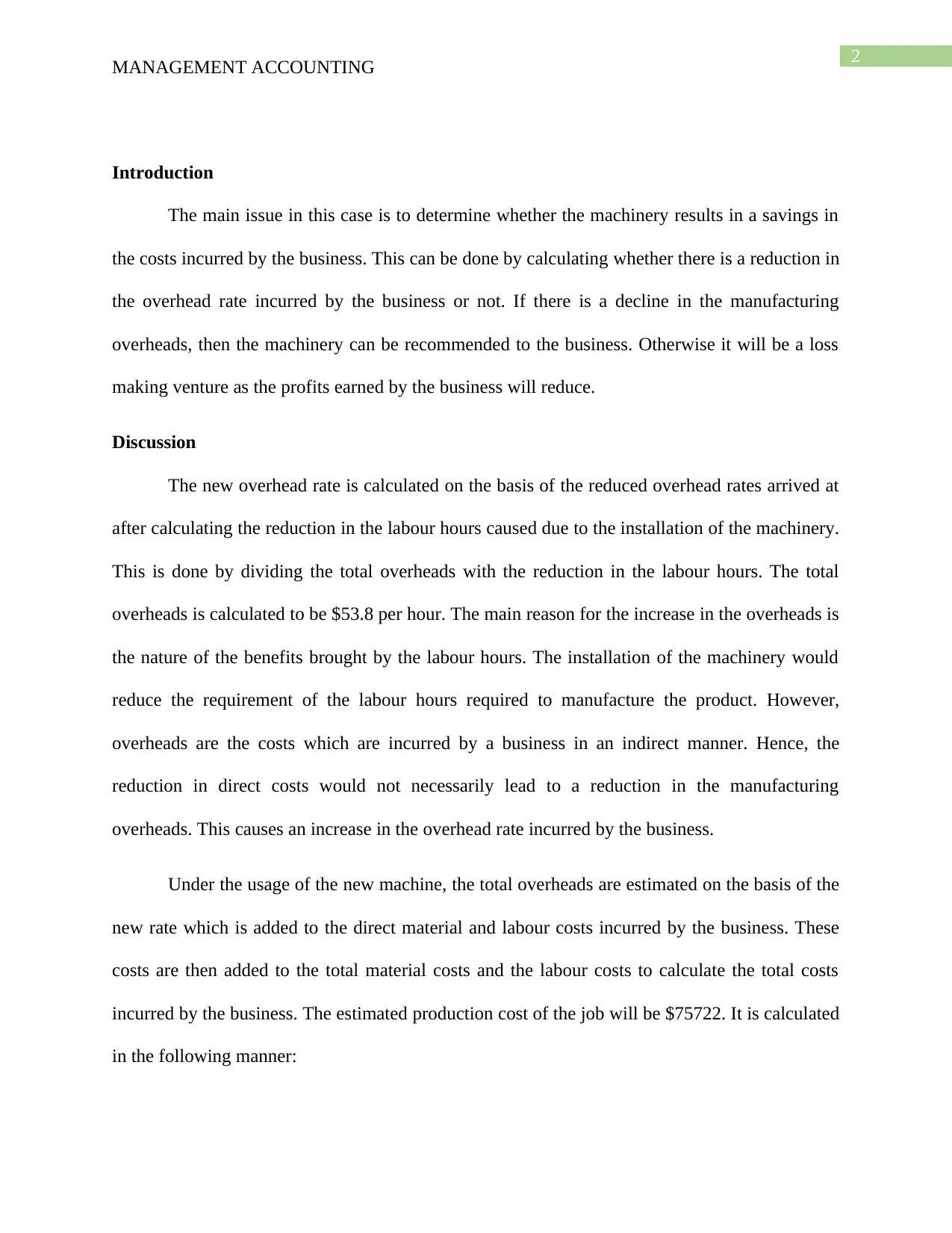
2
MANAGEMENT ACCOUNTING
Introduction
The main issue in this case is to determine whether the machinery results in a savings in
the costs incurred by the business. This can be done by calculating whether there is a reduction in
the overhead rate incurred by the business or not. If there is a decline in the manufacturing
overheads, then the machinery can be recommended to the business. Otherwise it will be a loss
making venture as the profits earned by the business will reduce.
Discussion
The new overhead rate is calculated on the basis of the reduced overhead rates arrived at
after calculating the reduction in the labour hours caused due to the installation of the machinery.
This is done by dividing the total overheads with the reduction in the labour hours. The total
overheads is calculated to be $53.8 per hour. The main reason for the increase in the overheads is
the nature of the benefits brought by the labour hours. The installation of the machinery would
reduce the requirement of the labour hours required to manufacture the product. However,
overheads are the costs which are incurred by a business in an indirect manner. Hence, the
reduction in direct costs would not necessarily lead to a reduction in the manufacturing
overheads. This causes an increase in the overhead rate incurred by the business.
Under the usage of the new machine, the total overheads are estimated on the basis of the
new rate which is added to the direct material and labour costs incurred by the business. These
costs are then added to the total material costs and the labour costs to calculate the total costs
incurred by the business. The estimated production cost of the job will be $75722. It is calculated
in the following manner:
MANAGEMENT ACCOUNTING
Introduction
The main issue in this case is to determine whether the machinery results in a savings in
the costs incurred by the business. This can be done by calculating whether there is a reduction in
the overhead rate incurred by the business or not. If there is a decline in the manufacturing
overheads, then the machinery can be recommended to the business. Otherwise it will be a loss
making venture as the profits earned by the business will reduce.
Discussion
The new overhead rate is calculated on the basis of the reduced overhead rates arrived at
after calculating the reduction in the labour hours caused due to the installation of the machinery.
This is done by dividing the total overheads with the reduction in the labour hours. The total
overheads is calculated to be $53.8 per hour. The main reason for the increase in the overheads is
the nature of the benefits brought by the labour hours. The installation of the machinery would
reduce the requirement of the labour hours required to manufacture the product. However,
overheads are the costs which are incurred by a business in an indirect manner. Hence, the
reduction in direct costs would not necessarily lead to a reduction in the manufacturing
overheads. This causes an increase in the overhead rate incurred by the business.
Under the usage of the new machine, the total overheads are estimated on the basis of the
new rate which is added to the direct material and labour costs incurred by the business. These
costs are then added to the total material costs and the labour costs to calculate the total costs
incurred by the business. The estimated production cost of the job will be $75722. It is calculated
in the following manner:
⊘ This is a preview!⊘
Do you want full access?
Subscribe today to unlock all pages.

Trusted by 1+ million students worldwide
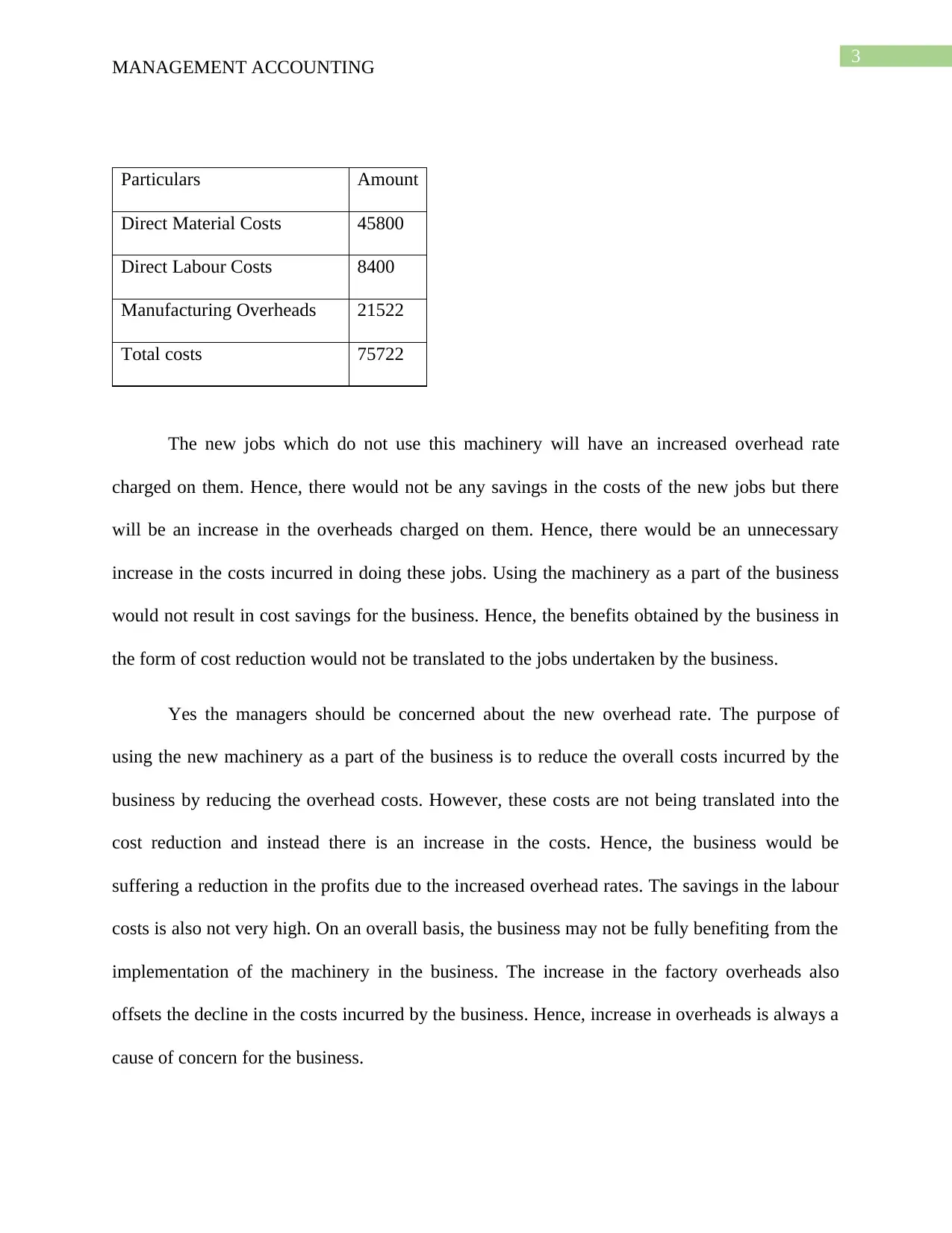
3
MANAGEMENT ACCOUNTING
Particulars Amount
Direct Material Costs 45800
Direct Labour Costs 8400
Manufacturing Overheads 21522
Total costs 75722
The new jobs which do not use this machinery will have an increased overhead rate
charged on them. Hence, there would not be any savings in the costs of the new jobs but there
will be an increase in the overheads charged on them. Hence, there would be an unnecessary
increase in the costs incurred in doing these jobs. Using the machinery as a part of the business
would not result in cost savings for the business. Hence, the benefits obtained by the business in
the form of cost reduction would not be translated to the jobs undertaken by the business.
Yes the managers should be concerned about the new overhead rate. The purpose of
using the new machinery as a part of the business is to reduce the overall costs incurred by the
business by reducing the overhead costs. However, these costs are not being translated into the
cost reduction and instead there is an increase in the costs. Hence, the business would be
suffering a reduction in the profits due to the increased overhead rates. The savings in the labour
costs is also not very high. On an overall basis, the business may not be fully benefiting from the
implementation of the machinery in the business. The increase in the factory overheads also
offsets the decline in the costs incurred by the business. Hence, increase in overheads is always a
cause of concern for the business.
MANAGEMENT ACCOUNTING
Particulars Amount
Direct Material Costs 45800
Direct Labour Costs 8400
Manufacturing Overheads 21522
Total costs 75722
The new jobs which do not use this machinery will have an increased overhead rate
charged on them. Hence, there would not be any savings in the costs of the new jobs but there
will be an increase in the overheads charged on them. Hence, there would be an unnecessary
increase in the costs incurred in doing these jobs. Using the machinery as a part of the business
would not result in cost savings for the business. Hence, the benefits obtained by the business in
the form of cost reduction would not be translated to the jobs undertaken by the business.
Yes the managers should be concerned about the new overhead rate. The purpose of
using the new machinery as a part of the business is to reduce the overall costs incurred by the
business by reducing the overhead costs. However, these costs are not being translated into the
cost reduction and instead there is an increase in the costs. Hence, the business would be
suffering a reduction in the profits due to the increased overhead rates. The savings in the labour
costs is also not very high. On an overall basis, the business may not be fully benefiting from the
implementation of the machinery in the business. The increase in the factory overheads also
offsets the decline in the costs incurred by the business. Hence, increase in overheads is always a
cause of concern for the business.
Paraphrase This Document
Need a fresh take? Get an instant paraphrase of this document with our AI Paraphraser
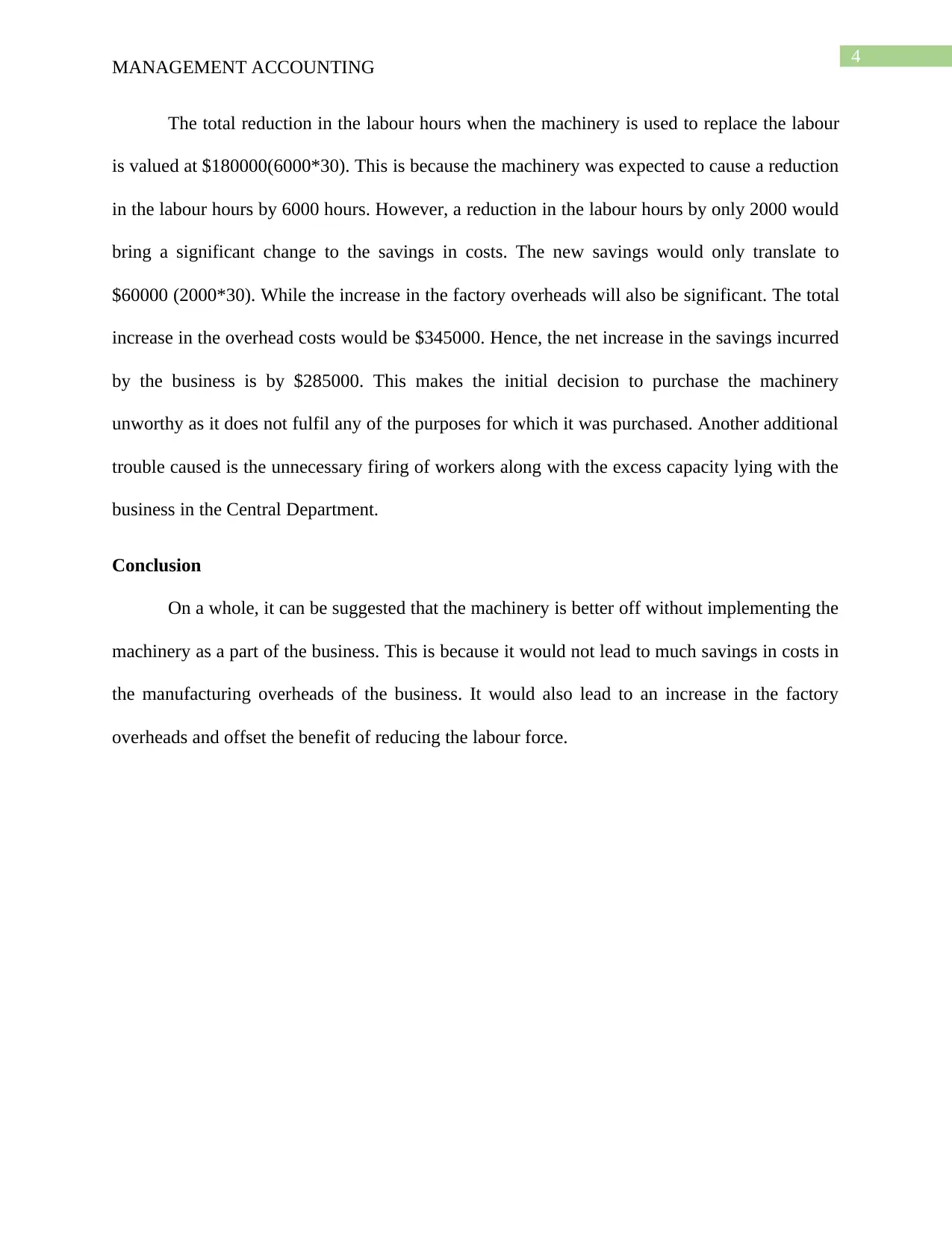
4
MANAGEMENT ACCOUNTING
The total reduction in the labour hours when the machinery is used to replace the labour
is valued at $180000(6000*30). This is because the machinery was expected to cause a reduction
in the labour hours by 6000 hours. However, a reduction in the labour hours by only 2000 would
bring a significant change to the savings in costs. The new savings would only translate to
$60000 (2000*30). While the increase in the factory overheads will also be significant. The total
increase in the overhead costs would be $345000. Hence, the net increase in the savings incurred
by the business is by $285000. This makes the initial decision to purchase the machinery
unworthy as it does not fulfil any of the purposes for which it was purchased. Another additional
trouble caused is the unnecessary firing of workers along with the excess capacity lying with the
business in the Central Department.
Conclusion
On a whole, it can be suggested that the machinery is better off without implementing the
machinery as a part of the business. This is because it would not lead to much savings in costs in
the manufacturing overheads of the business. It would also lead to an increase in the factory
overheads and offset the benefit of reducing the labour force.
MANAGEMENT ACCOUNTING
The total reduction in the labour hours when the machinery is used to replace the labour
is valued at $180000(6000*30). This is because the machinery was expected to cause a reduction
in the labour hours by 6000 hours. However, a reduction in the labour hours by only 2000 would
bring a significant change to the savings in costs. The new savings would only translate to
$60000 (2000*30). While the increase in the factory overheads will also be significant. The total
increase in the overhead costs would be $345000. Hence, the net increase in the savings incurred
by the business is by $285000. This makes the initial decision to purchase the machinery
unworthy as it does not fulfil any of the purposes for which it was purchased. Another additional
trouble caused is the unnecessary firing of workers along with the excess capacity lying with the
business in the Central Department.
Conclusion
On a whole, it can be suggested that the machinery is better off without implementing the
machinery as a part of the business. This is because it would not lead to much savings in costs in
the manufacturing overheads of the business. It would also lead to an increase in the factory
overheads and offset the benefit of reducing the labour force.
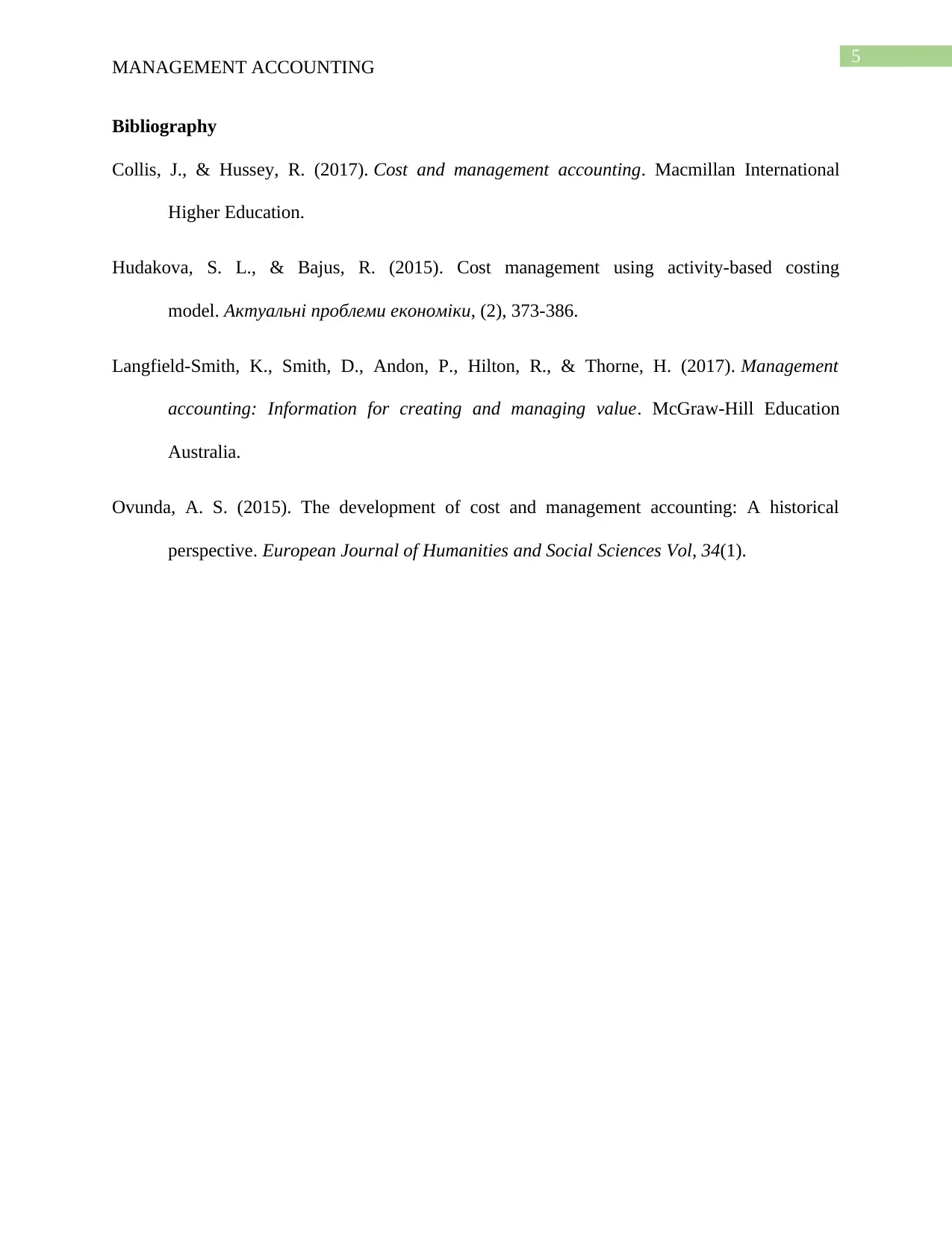
5
MANAGEMENT ACCOUNTING
Bibliography
Collis, J., & Hussey, R. (2017). Cost and management accounting. Macmillan International
Higher Education.
Hudakova, S. L., & Bajus, R. (2015). Cost management using activity-based costing
model. Актуальні проблеми економіки, (2), 373-386.
Langfield-Smith, K., Smith, D., Andon, P., Hilton, R., & Thorne, H. (2017). Management
accounting: Information for creating and managing value. McGraw-Hill Education
Australia.
Ovunda, A. S. (2015). The development of cost and management accounting: A historical
perspective. European Journal of Humanities and Social Sciences Vol, 34(1).
MANAGEMENT ACCOUNTING
Bibliography
Collis, J., & Hussey, R. (2017). Cost and management accounting. Macmillan International
Higher Education.
Hudakova, S. L., & Bajus, R. (2015). Cost management using activity-based costing
model. Актуальні проблеми економіки, (2), 373-386.
Langfield-Smith, K., Smith, D., Andon, P., Hilton, R., & Thorne, H. (2017). Management
accounting: Information for creating and managing value. McGraw-Hill Education
Australia.
Ovunda, A. S. (2015). The development of cost and management accounting: A historical
perspective. European Journal of Humanities and Social Sciences Vol, 34(1).
⊘ This is a preview!⊘
Do you want full access?
Subscribe today to unlock all pages.

Trusted by 1+ million students worldwide
1 out of 6
Related Documents
Your All-in-One AI-Powered Toolkit for Academic Success.
+13062052269
info@desklib.com
Available 24*7 on WhatsApp / Email
![[object Object]](/_next/static/media/star-bottom.7253800d.svg)
Unlock your academic potential
Copyright © 2020–2025 A2Z Services. All Rights Reserved. Developed and managed by ZUCOL.





